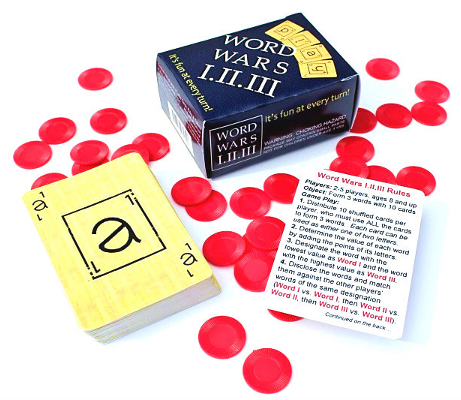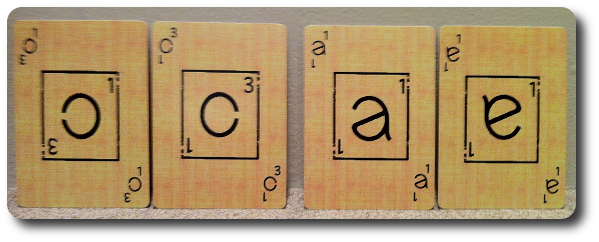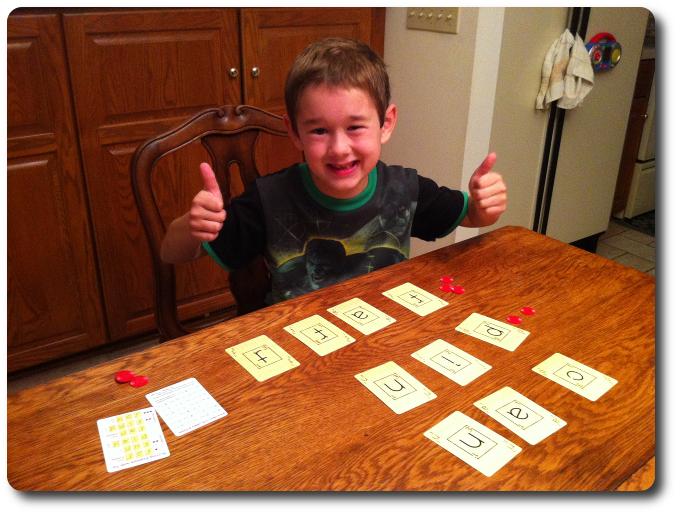
The Basics:
- For ages 12 and up
- For 2 to 5 players
- About 20 minutes to complete
Geek Skills:
- Reading
- Hand/Resource Management
Learning Curve:
- Child – Moderate
- Adult – Easy
Theme & Narrative:
- None
Endorsements:
- Gamer Geek approved!
- Parent Geek approved!
- Child Geek rejected!
Overview
Simply put, the goal is to create three words using all the cards available to you. Sound difficult? What if every card you had in your hand could be two different letters? That should certainly open up new possibilities! Suddenly the impossible becomes plausible as each player is given 20 letters to create only three words! Of course, points only go to the player who knows how to use their letters wisely.
Word Wars I.II.III, by INversionGAMES LLC, is comprised of 50 Letter cards and 30 mini Poker chips. This makes the game very easy to travel with and easy to store.
Game Set Up
To set up the game, shuffle the deck of Letter cards and deal to each player 10 cards, face down. The players then take their cards and look through them. The mini Poker chips are set aside and will be used for scoring.
You are now ready to play!
A War of Words
The goal of the game is to create three words using all 10 of the cards. What makes this game unique is that each Letter card can represent two different letters, depending on how the card is rotated. This is done through very creative and stylized fonts. For example, looking at a Letter card one way will show it is the letter “K”. Rotate the Letter card 180 degrees and the “K” becomes a “G”. This gives the player more letters but does not increase the number of cards. This creates a unique letter bank to create “possible words” but does not reduce the level of difficulty already inherent to the game as the players must still create words using whatever letters are available.

Example of the Letter cards: at left are the letters "O" and "C", at right are the letters "A" and "E"
There are no turns and all the players actively participate in three rounds. The rounds have no set length and are only finished after each player creates 3 words using all 10 of their cards or the players fold that round because they cannot make 3 words using all 10 cards.
To create a word, place the Letter cards together to form a word, rotating the cards to representing the letter needed. But creating a word is not enough. Each Letter card is worth points. Those points are based on the letter the Letter Card is representing for that round. Some letters are worth fewer points than others, like Scrabble. For example, the letter “A” is only worth 1 point, but the letter “Q” is worth 10 points.
After the players have created their three words, they count the points of each word by adding the values of the letters used. They then organize their three words putting the words that is worth the least amount of points at top and the word worth the most points at the bottom. The word with a value that is higher than the lowest value, but less than the highest value is placed in the middle. The end result will be three rows of words. Or words 1, 2, and 3, if you will.
The player’s then compare the values of each of their words. The player who created a correct word in the top row that is worth the most points is awarded 1 mini Poker chip, the player who created a correct word in the middle row that is worth the most points is awarded 2 mini Poker chips, and the player who created a correct word in the bottom row that is worth the most points is awarded 3 mini Poker chips. If players should ever tie for the most points, they both get the points for the words. For example, if three players have the same number of points for the word in the middle row, they all get 2 mini Poker chips.
Additionally, the player who scores on all three words is awarded a bonus of 4 mini Poker chips! No bonuses are awarded in ties or if another player cannot form 3 words.
If a player is unable to create 3 words with their cards, they are out for that round.
Winning the Game
The game continues for three rounds. After the third round, the player’s count their chips. The player with the most points wins the game!
To learn more about Word Wars I.II.III, see the game’s web site on the Game Crafter.
Prediction
Word games are becoming more popular in my household thanks to my little geeks learning how to read. My 7-year-old can now read just about anything you put in front of him and his younger brother, who is 4-years-old, can recognize a growing number of words. The 2-year-old still has a long way to go.
Learning how to read has opened up a lot of games to my 7-year-old. Before hand, and still the case for his 4-year-old brother, the ability to play a game was based on his prior experience and other players assisting him. Now my 7-year-old sits in his own chair, plays his own game, and participates as an equal. If you want to give your little geek a big ego boost, tell them they can control their own pieces in the game.
While reading and comprehension is soaring in my home, the same cannot be said about spelling. This is one of those strange facts about language where the mind can recognize and comprehend words faster than it can spell them. For example, I can read German out-loud and tell you what the words mean, but if you wanted me to spell those words, I would have a problem. The same can be said for my 7-year-old. He is doing very well at his spelling words in school, but his vocabulary is 100 times larger than the 12 spelling words he gets every week at school to memorize and spell.
With spelling games, this is where the frustration can set in. The player just knows there is a word to be found but just can’t seem to find it. It is this level of frustration that I am concerned about and might make the game fail to pleased some of the members of my test groups. Insurmountable odds of victory in a game are one thing. The inability to find a word because your own mind can’t see it is another. But let us also consider that each Letter card is two different letters. I have read that this will make the game easier for beginners and more challenging for experts. I agree with the statement in regards to it being more challenging for experts, but not the statement that suggests the game is easier for it. You are still stuck with only 10 Letter cards to use, but now you have 20 letters to select from. If you take one Letter card, you don’t have 19 remaining, you have 18.
The saving grace is the lack of time restraint in a round. The players can take as long as the majority of players allow. Without any time restrictions, my little geek can focus on the cards and making words without the added pressure of being forced to do so in a certain amount of time.
Explaining the game took a lot longer than expected. My little geek (and everyone else I taught the game to) understood the goal and how the game was played, but were continually confused about some of the letters. This is reasonable as some of the letters are not necessarily easy to identify. Lucky for everyone, the back of each card contains the entire alphabet using the stylized font. All a player needs to do is look at the back of their card and find the letter in question. Once the players started referencing the letters by using the back of their cards, they were set.
As I dealt the cards to my little geek, I asked him his thoughts on the game so far.
“I don’t know, Dad. I like how the letters can be two things at once, but I think this is going to be a really difficult game.” ~ Liam (age 7)
His concerns are valid, as far as I’m concerned. The suggested age for this game is 12 and up. My son is just about to flip 8, but I think he has excellent spelling skills and will be able to hold his own if given unlimited time. Let’s play the game and see if my prediction is correct.
Final Word
Word Wars I.II.III proved to be just too much of a brain burner for my little geek. To his credit, he played the entire game and did not complain once. He was able to make 3 words for 2 of the rounds, but was unable to for the first. This had both of us concerned, as he didn’t score any points. This was a punch to his gut, but he kept playing, even though I could see the frustration in his face. As the game progressed, he got better at it.
For my little geek, he was able to find words but it took him a long time. The stylized font that allowed for letters to be two letters at once was also throwing him and it threw me, too. Several times, we would score points on words with Letter cards that were not correct. For example (and shown in the below image), my little geek thought he spelled the word “FART”. He was understandably very proud of this achievement and I didn’t catch that he had used the wrong Letter card and had actually spelled the word “FAFT”. It was only after, when I was reviewing the images I took, that I caught the error. In the end, however, the game just proved to be a bit too much for him He decided it was a good game, but he just wasn’t ready for it yet. As such, we cannot recommend this game for players under the age of 12, as suggested by the designer.
Parent Geeks were also challenged but greatly enjoyed the game. This is especially true for those Parent Geeks who are Scrabble fans or fans of any word game. They loved the way the cards could rotate and giggled in delight when they formed a big word and groaned in disgust when they found that they only had two cards left to make their third word. This is where the game really shines in both its challenge and uniqueness. A player must manage their cards like a resource. For the Parent Geeks who had played games before, this was a different spin on word games they had not yet seen but were already familiar with. For the non-gamers, this proved to be a delightful challenge, but only for those who already enjoyed word games. If they didn’t, it was clear their level of frustration was higher than their level of enjoyment.
Gamer Geeks were mixed, but the majority agreed it was a good game. In fact, it was suggested that if a word game had to be played, this was going to be the one to pick. It provided the Gamer Geeks a unique challenge both in word creation and attempting to out score their opponents. For those Gamer Geeks who did not enjoy word games, they agreed it was a neat idea and well designed, but not a game they would seek out.

The look of excitement and pride is very visible on my little geek's face when he scored points
Gamer Geeks, this game is approved but only if you already enjoy word games. If you don’t, then I don’t know why you are playing a word game to begin with. Expect to be challenged and to be tempted to take the easy words. Don’t fall for it! Put those three-letter words aside and go for the big score, but keep in mind you are fixed to 10 cards and must make 3 words. The Devil is in the details for this game and you will get poked if you don’t appreciate the level of complexity put in front of you.
Parent Geeks, this is a very unique word game that will be fun to play with family and friends. The game only last three rounds and the scoring mechanism rewards complex words rather than long words. In fact, the longer your word, the less points you might received because you have to create 3 words to score anything to being with. Non-gamers will enjoy this game, but like the Gamer Geeks, only if words games are already enjoyed.
Child Geeks, this is a difficult game and might very well proved to be a bit too much for you at the moment. The letters can be confusing and the limited cards available to you can be frustrating. It is a very good game, however, and one you will one day be able to play.
I really enjoyed Word Wars I.II.III. I found it to be terribly frustrating and rewarding, leaving me giddy when I was able to make three simple words. Only three! And yet, it felt like an incredible feat of intelligence. This is especially true when you score points. It really is a challenge of intellect and seeing words in a cloud of limited possibilities is a great puzzle to solve. If you are a fan of word games, do take a moment to look into Word Wars I.II.III.
This game was given to Father Geek as a review copy. Father Geek was not paid, bribed, wined, dined, or threatened in vain hopes of influencing this review. Such is the statuesque and legendary integrity of Father Geek.




Please note that there is a Kickstarter project available until June 17th where you can pledge to get a copy of a tile version of this card game. As an additional perk, you can get this card game as a bonus game if you pledge at a certain amount!